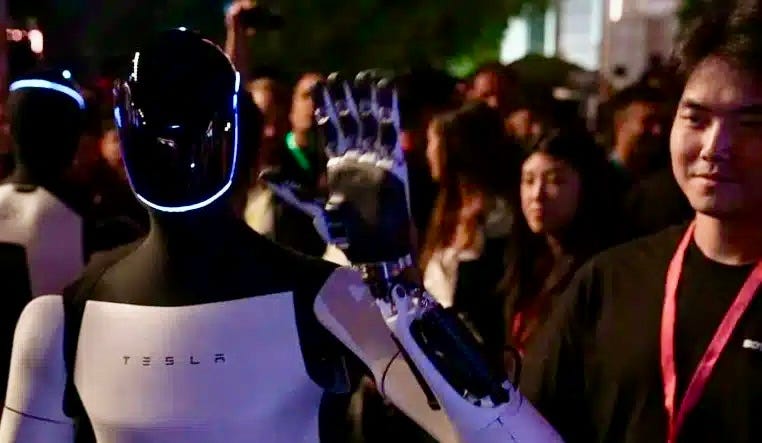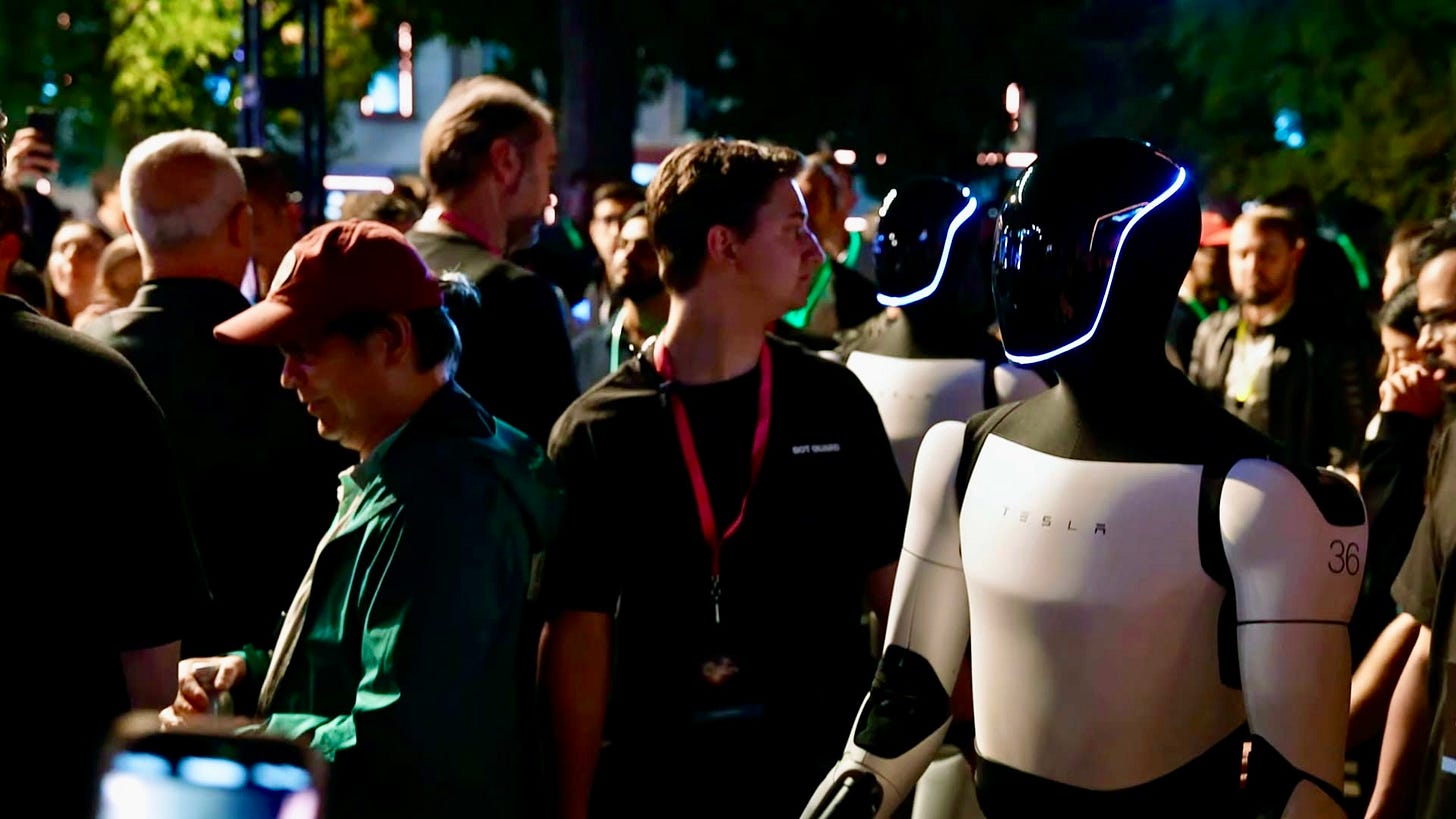Elon Musk's beer-pouring 'robots' are more like puppets
The Optimus robots trotted out at yesterday's Teslafest aren't the social, capable, autonomous AI robots we're led to believe.
Tesla rolled out two shiny new cars in Burbank yesterday.
With Elon Musk presiding over the company's "We, Robot" event at the Warner Bros. Studios, Tesla showcased a self-driving two-seat "robo-taxi" without a steering wheel or pedals and designed to cost less than $30,000 when it ships in 2027, according to the company. They also showed a 20-passenger art deco van.
Wall Street was unimpressed. Tesla's stock dropped 8%.
The star of the show was the Optimus robot. Optimi danced, mingled, took selfies, and even tended the bar during the event.
Musk implied, and led attendees to believe, that the robots are AI-controlled, autonomous, and highly capable — "the most significant product ever created," he said.
"You'll be able to walk right up to them, and they will serve drinks," Musk said. Optimus "will do anything you want" and work as a teacher, watching over your children, walking your dog, mowing the lawn, and even fetching groceries" — implying an Optimus-enabled lifestyle of lying around drinking cocktails.
Unfortunately, it's an illusion.
Cagey robots
Musk wanted everyone to believe Optimus robots were autonomous, but they were not. They were more puppets than artificial humans.
The robots were mostly teleoperated. Remote humans wired up with headsets, special gloves, and other gear were actually the intelligent entities that interacted with guests and made drinks. To the operators, it was like they were in a virtual reality game, where their movements were transmitted to the robots to control their heads, arms, and hands in real time, and video and audio feedback were relayed from the robots to the operators.
The talking part was almost certainly just a guy on the other end listening and talking, pretending to be an AI mind, and throwing his voice like a ventriloquist, albeit electronically.
The actual walking part, involving balanced locomotion, was AI-controlled. It's very impressive but with the risk of toppling over, as evidenced by the accompaniment of Tesla "spotters" on either side of every robot. That's sensible. The prototypes are expensive.
We already know that Telsa is using teleportation to train Optimus robots. Being controlled by a human is a normal part of their development. Robot and AI nerd Kevin Wood walks us through it on YouTube.
My friend Robert Scoble, present at the event, simply asked one of the robots if it was autonomous or remotely controlled by a person. The “robot” was evasive. But when pressed, it said there "might be some" autonomous components.
"Not wholly AI? Not at all AI," wrote venture capitalist Josh Wolfe, co-founder of Lux Capital on X. "Totally worthy to celebrate low latency remote control but totally dishonest to demo these as autonomous robots — call it the parlor trick it is."
The humanoid robot "parlor trick"
Wolfe got it right. Everything about Optimus robots should be impressive — the technology, design, and the progress Tesla engineers have made. But Elon Musk's impulse to bullshit everyone spoils it.
Based on Musk's comments and the interaction with the robots mingling with the crowd, it's clear that Musk's and Tesla's "policy" on whether or not these robots are autonomous AI robots is to obfuscate, misdirect, and mislead.
The clear intent was to dazzle everyone with Tesla's progress in robotics by leading them to believe something untrue. Again, it should be impressive, but the lie sours the achievement.
We've been here before, with Musk's misdirection intended to convince everyone that Tesla is more advanced than it is.
In 2016, Musk promised Level 5 autonomous Tesla vehicles that could travel unmanned from Los Angeles to New York by 2018. Never happened.
In 2019, Musk claimed Tesla would have over a million robotaxis on the road by 2020. Never happened.
In 2019, Musk announced that the Cybertruck model would start at $39,900, but the actual starting price in 2023 was $60,990.
In 2019, Musk claimed the Cybertruck would have a 500-mile range, but the actual range is around 320 miles.
In 2021, Musk said the Cybertruck would have four-wheel steering and move diagonally like a crab, features that were never implemented.
Tesla's humanoid robots are really part of a larger intent by the entire humanoid robot industry to trick and delude people.
The trouble with humanoid robots
There are all kinds of robots, mostly industrial robots bolted to the floor that do factory assembly work. Tesla’s main secret sauce in manufacturing is its incredible industrial robots.
But humanoid robots are weird. Like people, they have feet, legs that bend at the knee, torsos, arms with hands and fingers, shoulders, necks, heads, and something that passes for a face.
Why?
The most advanced humanoid robots include Agility Robotics' Digit, Apptronik's Apollo, Figure AI's Figure 02, Boston Dynamics' new, improved Atlas, UBTECH Robotics' Walker and others.
Humanoid robots, we're told, are the size, general shape and have parts designed after human body parts because our environments, buildings and vehicles are designed for people. By making a robot that works and bends like a human body, the robots can function in our environments.
But that raises the question: Why go so far? Why, for example, does a robot need a human-shaped head and a face in the front?
The real reason, I'm convinced, is the psychological impact of humanoid robots on people. Robot makers want to stimulate "cognitive anthropomorphism," where our brains can't help but think they're kind of human.
A study conducted by scientists at the University of Genova and the Italian Institute of Technology found that, while non-humanoid robots are perceived as objects, humanoid robots are often perceived as "human-like" or "social agents" — not objects.
Research by scientists at Tampere University in Finland found that eye contact with robots elicits the same response eye contact elicits when two people look at each other.
Another study conducted at IRCCS Centro Neurolesi Bonino Pulejo in Messina, Italy, found that robots programmed for "emotional intelligence" can evoke empathy in people, "especially when they exhibit anthropomorphic traits."
Elon Musk says he wants people to think of Optimus as a "friend" to which they "get quite attached." Why does he want that?
Ultimately, the main difference between regular robots and humanoid robots is their psychological impact on people.
Consider a crunchy paid subscription!
You’re reading the free version of Machine Society. I’m committed to making the free version super valuable to readers. As a free subscriber, you get everything minus the last bits of about half the columns I write. I make sure the non-paywalled parts of my columns are valuable by themselves and packed with information and insights. Of course, the paid version offers a little more.
If you’d like to subscribe to the paid version, it costs $4.17 per month — more or less the price of a bag of potato chips.
Machine Society is a unique (and uniquely insightful) perspective on technology changing human culture, society, politics, and economics.
It’s all that and a bag of chips.
Dispatches from the digital frontier
Why you should want face-recognition glasses
Never mind that recent project by two Harvard students showing how face-recognition glasses are a huge invasion of privacy. The glasses aren’t where danger lies! Read my opinion column at Computerworld.
Plus:
Is AI saving cyber security jobs… or taking them?
Google, it’s time to kill CAPTCHAS
Everything you always wanted to know about the AI PC trend
My location: Fez, Morocco
(Why Mike is always traveling.)










